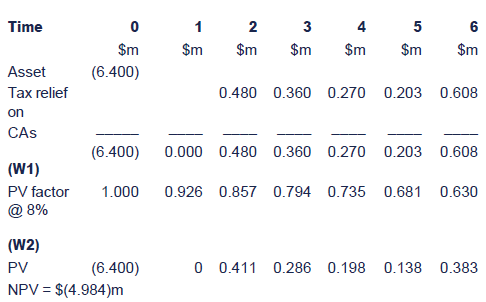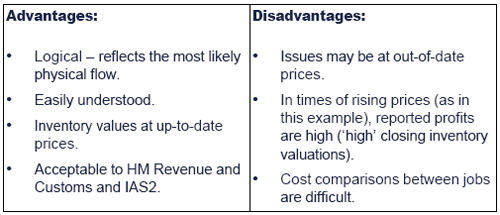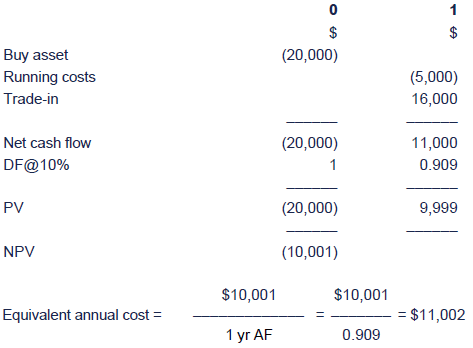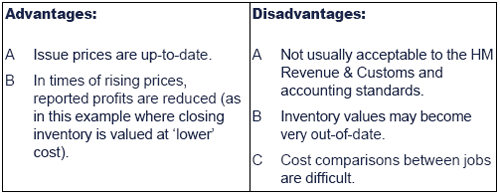Asset investment decision
When a business spends money on new non-current assets it is known as capital investment or capital expenditure. Spending may be for:
maintenance
profitability
expansion
indirect purposes.
Spending is normally irregular and for large amounts. It is expected to generate long-term benefits.
A wider discussion of investment appraisal techniques can be found here.
Capital budgeting
A capital budget is a programme of capital expenditure covering several years
Capital budgeting process
The capital budgeting process (capital investment decision-making process) consists of a number of stages:

When a proposed capital project is evaluated, the costs and benefits of the project should be evaluated over its foreseeable life.This is usually the expected useful life of the non-current asset to be purchased, which will be several years. This means that estimates of future costs and benefits call for long-term forecasting.
A 'typical' capital project involves an immediate purchase of a non-current asset. The asset is then used for a number of years, during which it is used to increase sales revenue or to achieve savings in operating costs. There will also be running costs for the asset. At the end of the asset's commercially useful life, it might have a 'residual value'. For example, it might be sold for scrap or in a second-hand market. (Items such as motor vehicles and printing machines often have a significant residual value.)
A problem with long-term forecasting of revenues, savings and costs is that forecasts can be inaccurate. However, although it is extremely difficult to produce reliable forecasts, every effort should be made to make them as reliable as possible.
A business should try to avoid spending money on non-current assets on the basis of wildly optimistic and unrealistic forecasts.
The assumptions on which the forecasts are based should be stated clearly. If the assumptions are clear, the forecasts can be assessed for reasonableness by the individuals who are asked to authorise the spending.
Lease versus buy decisions
Once the decision has been made to acquire an asset for an investment project, a decision still needs to be made as to how to finance it. A popular choices in this type of decision is whether to lease or buy.
The NPVs of the financing cash flows for both options are found and compared and the lowest cost option selected.
The finance decision is considered separately from the investment decision. The operating costs and revenues from the investment will be common in each case.
Only the relevant cash flows arising as a result of the type of finance are included in the NPV calculation.
Leasing
The asset is never 'owned' by the user company from the perspective of the taxman.
Implications
The relevant cash flows would thus be:
Buying
The assumption is that buying requires the use of a bank loan (for the sake of comparability). The user is the owner of the asset.
Implication
The relevant cash flows would be:
Cost of capital
As the interest payments attract tax relief we must use the post-tax cost of borrowing as our discount rate when comparing the finance costs of leasing and buying. As all financing cash flows are considered to be risk-free, this rate is used for both leasing and buying.
Post-tax cost of borrowing = Cost of borrowing × (1 - Tax rate).
Example of a lease versus buying calculation
A firm has decided to acquire a new machine to neutralise the toxic waste produced by its refining plant. The machine would cost $6.4 million and would have an economic life of five years.
Writing down allowances (WDAs) of 25% pa on a reducing balance basis are available for the investment.
Taxation of 30% is payable on operating cash flows, one year in arrears.
The firm intends to finance the new plant by means of a five-year fixed interest loan at a pre-tax cost of 11.4% pa, principal repayable in five years' time.
As an alternative, a leasing company has proposed a finance lease over five years at $1.42 million pa payable in advance.
Scrap value of the machine under each financing alternative will be zero.
Evaluate the two options for acquiring the machine and advise the company on the best alternative.
Solution:
W1) Calculation of the tax relief on WDAs if asset bought:

Note: The asset is bought at time t=0 as usual with the first CA in the year ended time one. Given the one-year time lag on the tax, the first tax effect is at time t=2.
(W2) Calculation of the post-tax cost of borrowing.
The pre-tax cost of borrowing is 11.4%.
The post-tax cost of borrowing can be approximated by multiplying this by (1 - tax rate), i.e. 11.4% × (1- 0.3) = 7.98%, say 8%(strictly this ignores the impact of a one-year time delay on tax relief, but this is acceptable).
Cost of borrowing to buy:

Cost of leasing:

The cost of leasing is lower than the cost of buying and the asset should therefore be acquired under a finance lease.
Other lease/buy considerations
There may be other issues to consider before a final decision is made to lease or buy, for example:
Who receives the residual value in the lease agreement?
Any restrictions associated with the taking on of leased equipment, e.g. leases may restrict a firm's borrowing capacity.
Any additional benefits associated with lease agreement, e.g. maintenance or other support services.
Replacement decisions
Once the decision has been made to acquire an asset for a long-term project, it is quite likely that the asset will need to be replaced periodically throughout the life of the project.
Where there are competing replacements for a particular asset it is important for a company to compare the possible replacement strategies available.
A problem arises where
equivalent assets available are likely to last for different lengths of time or
an asset, once bought, must be replaced at regular intervals.
The decision is how often should the asset be replaced?
Equivalent annual costs (EACs)
In order to deal with the different time-scales, the NPV of each option is converted into an annuity or an EAC.
The EAC is the equal annual cash flow (annuity) to which a series of uneven cash flows is equivalent in PV terms.
The formula used is:

The optimum replacement period (cycle) will be the period that has the lowest EAC, although in practice other factors may influence the final decision.
The method can be summarised as:
(1)calculate the NPV of each strategy or replacement cycle
(2)calculate the EAC for each strategy
(3)choose the strategy with the lowest EAC.
Key assumptions
Cash inflows from trading are ignored since they will be similar regardless of the replacement decision. In practice using an older asset may result in lower quality, which in turn could affect sales.
The operating efficiency of machines will be similar with differing machines or with machines of differing ages.
The assets will be replaced in perpetuity or at least into the foreseeable future.
In most questions tax and inflation are ignored.
As with all NPV calculations non-financial aspects such as pollution and safety are ignored. An older machine may have a higher chance of employee accidents and may produce more pollution.
Determining the optimum replacement period (cycle) will largely be influenced by:
the capital cost/resale value of the asset as the longer the period, the less frequently these will occur
the annual operating costs of running the asset as the longer the period, the higher these will become.
Example of replacement decision
A machine costs $20,000.
The following information is also available:
Running costs (payable at the end of the year):

Calculate the optimal replacement cycle if the cost of capital is 10%.
Solution:
One-year replacement cycle:

Two-year replacement cycle:

The machine should therefore be replaced after two years.
Limitations of replacement analysis
The model assumes that when an asset is replaced, the replacement is in all practical respects identical to the last one and that this process will continue for the foreseeable future. However in practice this will not hold true owing to:
Equivalent annual benefits
The equivalent annual benefit (EAB) is the annual annuity with the same value as the net present value of an investment project.
It can be calculated using a similar formula to that used for the equivalent annual cost:

Calculating the EAB is particularly useful when trying to compare projects with unequal lives. The project with the highest EAB would be preferred.
|
Created at 9/5/2012 3:05 PM by System Account
(GMT) Greenwich Mean Time : Dublin, Edinburgh, Lisbon, London
|
Last modified at 11/13/2012 12:29 PM by System Account
(GMT) Greenwich Mean Time : Dublin, Edinburgh, Lisbon, London
|
|
|
|
 |
Rating
:
|
 Ratings & Comments
(Click the stars to rate the page) Ratings & Comments
(Click the stars to rate the page)
|
 |
Tags:
|
|
|
|
|